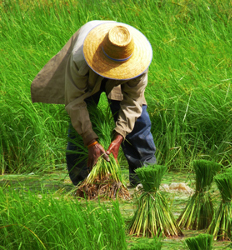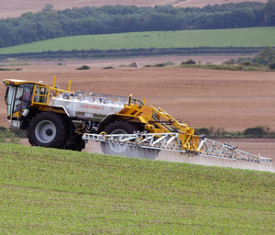 So we've touched the issue from a few years ago, of arsenic in apple juice, but what has taken its place in the limelight is rice. Rice is a staple in the diet of people around the world. Towards the end of 2012, Consumer Reports did a large study of arsenic levels in a variety of rice and rice products commonly sold here in the U.S.[5]
So we've touched the issue from a few years ago, of arsenic in apple juice, but what has taken its place in the limelight is rice. Rice is a staple in the diet of people around the world. Towards the end of 2012, Consumer Reports did a large study of arsenic levels in a variety of rice and rice products commonly sold here in the U.S.[5]
_Like the testing of apple juice, nearly every form of rice tested had measurable amounts of arsenic, both the organic and more toxic inorganic forms. On the heels of this research, the FDA did a separate evaluation of many of the same products and again, like with apple juice, found lower levels of arsenic than published in previous research. With the finding of levels (of both organic and inorganic arsenic) averaging below the 10 ppb threshold that is now in place for drinking water and juice, the FDA essentially recommends nothing other than eating a balanced diet and thoroughly rinsing white rice.[6]
_ It's interesting to note that both studies found higher levels of arsenic in brown rice. Yes, the same brown rice that many choose as the healthier alternative over more refined white rice, and with regard to white rice, the more it is rinsed prior to being prepared and consumed, the more nutrient value is stripped away. Though the FDA recommendation to ‘diversify the diet’ and to eat a greater variety of foods sounds like a great idea, if you're eating rice, breakfast cereal, rice 'milk', apple juice, snack bars, foods that contain brown rice syrup, grapes, baby formula, pear juice, or any number of things, you will still likely be consuming measurable amounts of arsenic. Talk about a catch-22!
It's interesting to note that both studies found higher levels of arsenic in brown rice. Yes, the same brown rice that many choose as the healthier alternative over more refined white rice, and with regard to white rice, the more it is rinsed prior to being prepared and consumed, the more nutrient value is stripped away. Though the FDA recommendation to ‘diversify the diet’ and to eat a greater variety of foods sounds like a great idea, if you're eating rice, breakfast cereal, rice 'milk', apple juice, snack bars, foods that contain brown rice syrup, grapes, baby formula, pear juice, or any number of things, you will still likely be consuming measurable amounts of arsenic. Talk about a catch-22!
_ At this point, you might think that we would finally have stopped using arsenic in food production, but when you considering how relatively recent it was that some of the last arsenicals were banned for agricultural use, you would be wrong. More troubling, even as recently as last year, the FDA still trying to limit the reintroduction of arsenic into the food supply via arsenic-containing poultry feed components by drug makers Pfizer and Alpharma.[7] This was not even a year ago, and by the time the agency did take action, the producers had seen the writing on the wall and ceased production in the U.S. (it was and is still produced for sale and use overseas).
At this point, you might think that we would finally have stopped using arsenic in food production, but when you considering how relatively recent it was that some of the last arsenicals were banned for agricultural use, you would be wrong. More troubling, even as recently as last year, the FDA still trying to limit the reintroduction of arsenic into the food supply via arsenic-containing poultry feed components by drug makers Pfizer and Alpharma.[7] This was not even a year ago, and by the time the agency did take action, the producers had seen the writing on the wall and ceased production in the U.S. (it was and is still produced for sale and use overseas).
_One of these three drugs, Roxarsone, was re-approved for use as recently as 2009, but has been in use since it was first approved in 1944. Though the drug uses the less toxic organic form of arsenic, arsenic can and does change form. An examination of chicken litter from poultry that had been administered this drug showed higher concentrations of organic arsenic as well as levels of inorganic arsenic. As a result, four rice farmers in Arkansas filed a lawsuit against large poultry producers. Chicken litter from poultry producers is sold as fertilizer, and in Arkansas where much of this country's chicken and most of its rice comes from, this fertilizer often ends up in rice fields.
_ So to simplify this, the theory is,
So to simplify this, the theory is,
- Poultry administered arsenic based drugs to increase weight and fight a digestive tract disease.
- Some of the arsenic changes form to the more toxic inorganic form.
- Concentrated organic and now the more toxic inorganic arsenic comes out in chicken excrement.
- Chicken excrement/litter is sold as fertilizer and spread on American rice fields.
_Ultimately the lawsuit was dismissed, with the National Chicken Council noting that the findings of the research reflected
